The popularity of paddle boarding has led to an increased interest in paddle board trolling motors, which offer motorized assistance for exploring, fishing, or simply enjoying a leisurely cruise on the water. These motors attach to paddle boards and provide thrust, allowing users to cover greater distances or conserve energy while paddling.
With various options available, choosing the best paddle board trolling motor depends on individual needs and preferences. This guide explores 5 top contenders in the market for 2024, highlighting their key features and considerations to help you make an informed decision.
3 Type of Paddle Board Trolling Motor
Let’s explore three common paddle board trolling motors to enhance your SUP experience.
Option 1: After Market Motor Mount
The paddle board with trolling motor trend has gained traction, offering a unique blend of paddling and motorized exploration. For those seeking adaptability, aftermarket motor mounts present a compelling solution.
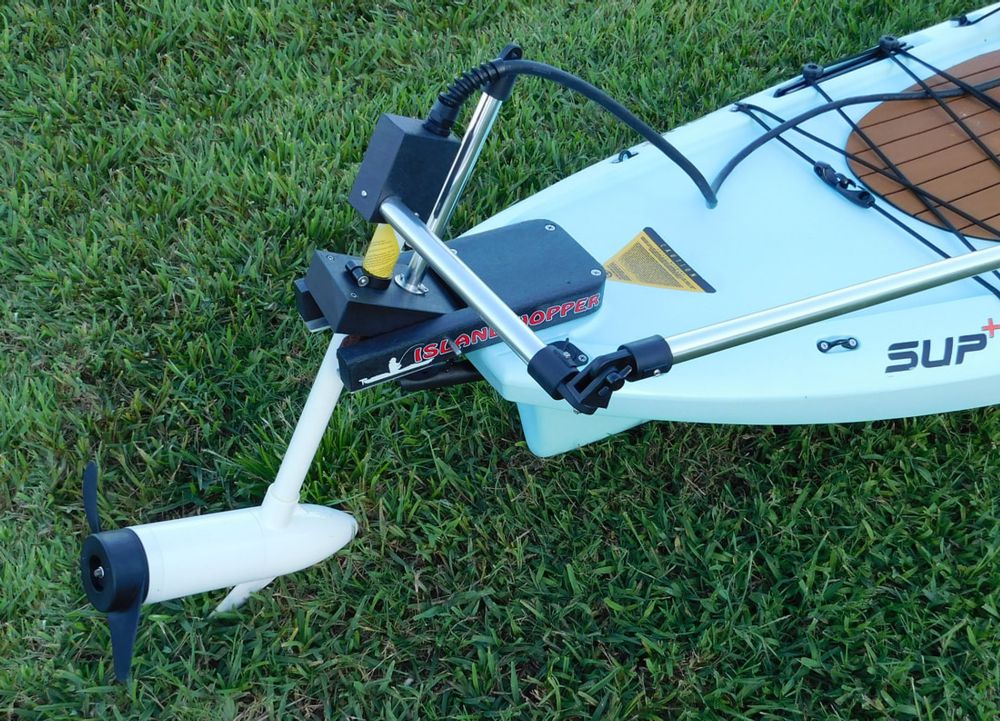
These mounts, typically crafted from durable materials like nylon or aluminum, attach to various paddle board models without requiring permanent modifications. They often feature adjustable components to accommodate different motor sizes and shaft lengths, ensuring compatibility with a broader range of trolling motors.
Aftermarket motor mounts offer a flexible and budget-friendly entry point into the world of paddle board with trolling motor setups. However, choosing a mount specifically designed for your board and motor combination is crucial to ensure safe and optimal performance.
Option 2: DIY Transom Mount
If you want to outfit your paddle board with a trolling motor on a paddle board, a DIY transom mount is a popular option. This method involves building your mount to attach a small trolling motor to your board’s back (transom). This allows you to propel your board without paddling, freeing up your hands for fishing or relaxing.

While prefabricated mounts are available, DIY options offer customization and potential cost savings. A basic DIY transom mount typically involves attaching a small wooden board to the rear of the paddle board, providing a sturdy platform to secure your trolling motor. Numerous online resources provide step-by-step instructions and demonstrate various design approaches, ensuring your project’s success.
Option 3: Electric Fin
You have a few options if you want to add a motor to your paddle board. Aftermarket motor mounts and DIY transom mounts offer solutions. Still, the most streamlined and practical approach is the electric fin motor.

An electric fin motor is designed to replace your paddle board’s center fin. These motors include batteries and sometimes even remote controls, all built into a compact and streamlined unit. This design integrates seamlessly with your existing board, maximizing convenience and storage ease.
The electric fin avoids problems with other solutions, like the drag of aftermarket mounts or the potential instability of DIY builds. It truly offers a purpose-built design explicitly intended for paddle board use.
Overall, a trolling motor is often seen as a superior option for fishing compared to an electric fin, as it enhances control and boosts the board’s speed, despite the drawback of a larger battery pack.
On the other hand, for those seeking a family-friendly choice, an electric fin emerges as a safer alternative. It ensures a more secure paddling experience, with the added benefit of a wireless remote being a safer option than a transom-mounted propeller
Top 5 Paddle Board Trolling Motor
If you prefer a completely integrated experience, let’s explore some of the top trolling motors for paddle board on the market.
1. MotorGuide Xi3 Wireless Freshwater Bow Mount Pontoon Trolling Motor
The MotorGuide Xi3 is a top-rated bow mount trolling motor for kayaks and SUPs. It has wireless control, and the short shaft (ideal for paddle boards) makes it user-friendly. The “anchor” mode lets you stay put while fishing. Powered by a 12V battery, it propels you faster than paddling. Notably quiet, it won’t disturb fish or disrupt your nature experience. A saltwater version exists, but its longer shaft (48″ minimum) is less suitable for paddle boards.

Specs:
- Weight: 41 lbs
- Mount: bow
- Shaft Length: 48″
- Thrust: 55 lbs
- Battery: 12V
- Price: $890 – $1500
Pros:
- Wireless control
- Short shaft (perfect for SUPs)
- Anchor mode
- Quiet operation
Cons:
- Limited to bow mounting only
- It uses brushed motor technology, making it noisier than newer brushless motors
2. Newport Vessels Transom Mounted Saltwater Electric Trolling Motor
Due to its shorter shaft, Newport Vessels offers a 55-pound thrust trolling motor ideal for paddle boards. The transom mount and extendable handle provide versatile mounting options, allowing you to customize your setup. Despite its affordability, it boasts a good range of speeds, giving you control over your paddling experience.

Specs:
- Weight: 23 lbs
- Mount: transom
- Shaft Length: 24″
- Thrust: 55 lbs
- Battery: 12V
- Price: $199
Pros:
- Short shaft (ideal for SUP)
- Multiple mount options
- Extendable handle for customization
- Good speed range for the price
Cons:
- No GPS anchor option; require manual adjustment
3. Newport Vessels NK180 Trolling Motor
The NK180 packs a punch, reaching speeds of 5mph, which is impressive for a small SUP motor. It offers smooth forward/reverse control and multiple steering options. But beware, its power comes at a cost. It requires a heavier 24V battery (40-50 lbs) compared to the standard 12V, adding significant weight (around 68 lbs total) that your SUP might not be able to handle. Consider your board’s capacity before choosing this powerful option.

Specs:
- Weight: 18.25 lbs
- Mount: transom
- Shaft Length: 19.7″
- Thrust: 60 lbs
- Battery: 24V
- Price: $999
Pros:
- Powerful for a small SUP motor.
- Stepless speed selector for effortless forward/reverse
- Customizable steering
Cons:
- Short battery life
- Adding significant weight due to the 24V battery
4. Minn Kota Endura C2
A popular choice for paddle boards, the Minn Kota Endura C2 offers versatility with various shaft lengths and thrust options. This allows you to tailor the motor to your fishing environment. Its easy depth and tilt adjustments are also ideal for paddle boards due to their proximity to the water’s surface. The bracket configuration is also user-friendly for mounting on a DIY paddle board transom setup.

Specs:
- Weight: 17 lbs
- Mount: bow
- Shaft Length: 30″
- Thrust: 30 lbs
- Battery: 12V
- Price: $222
Pros:
- Various shaft lengths and thrust options
- Depth and tilt ideal for shallow water (SUPs)
- DIY friendly
Cons:
- Prop may get stuck in the weeds
- Not very powerful
5. Boost Fin Electric Fin
This innovative Boost Surfing Fin brings effortless cruising to your inflatable paddleboard or kayak, offering universal compatibility for most models. You can take control with two convenient options: a user-friendly 2-button wristband controller or a downloadable phone app.

In addition, this lightweight fin (only 2.7 lbs) lets you choose your ideal power level, ensuring a smooth ride for up to 100 minutes on a single charge. The fin boasts 800 watts of power, providing ample thrust for exploration while maintaining a beginner-friendly, controlled takeoff.
Specs:
- Weight: 2.7 lbs
- Shaft Length: 10.5″
- Thrust: 20 lbs
- Battery: 24V
- Price: $500 – $800
Pros:
- The fin is self-contained, requiring no messy wires for a streamlined setup
- Enjoy ample power for paddling adventures
- Convenient wristband controller & phone app
- Quick and easy installation
- Secure Connection
- Beginner-friendly
Cons:
- US Fin Box adapter needs a separate wrench
- Requires screwdriver for startup
5 Factors to Consider When Choosing a Paddle Board Trolling Motor
Now that you’re familiar with your options, let’s explore some key factors when selecting the ideal trolling motor on a paddle board for your needs.
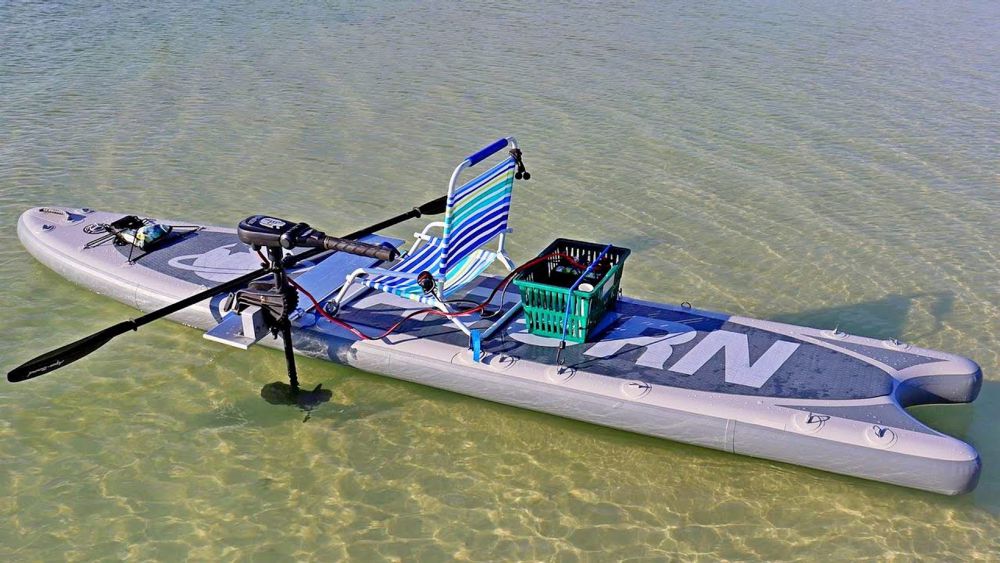
1. Mount
A well-designed trolling motor mount for paddle board significantly impacts performance in several ways:
- Stability: A secure mount minimizes wobbling, enhancing balance and control of your board, especially when battling wind or currents.
- Motor placement: Optimal positioning ensures the propeller functions efficiently and delivers proper thrust, directly affecting maneuverability, speed, and overall efficiency. A poorly placed motor can create drag, reduce battery life, and hinder steering.
- Durability: A robust mount should withstand the vibrations and stresses associated with motor operation, especially in saltwater environments.
2. Weight
The weight of a trolling motor on paddle board significantly impacts its performance and overall user experience on your paddle board:
- Battery life: Lighter motors consume less battery power, allowing longer trips on a single charge. This is crucial, especially for extended fishing expeditions.
- Motor thrust: Heavier motors often pack more power, translating to more decisive thrust and better handling in currents or windy conditions. However, this benefit comes at the cost of increased weight and potentially reduced battery life.
- Maneuverability: A lighter motor allows easier handling and maneuverability, making it ideal for smaller paddle boards or users who prioritize agility.
Finding the right balance between weight, power, and battery life depends on individual needs and preferences. For instance, a lightweight, low-power motor might suffice if you prioritize long, leisurely fishing trips on calm waters.
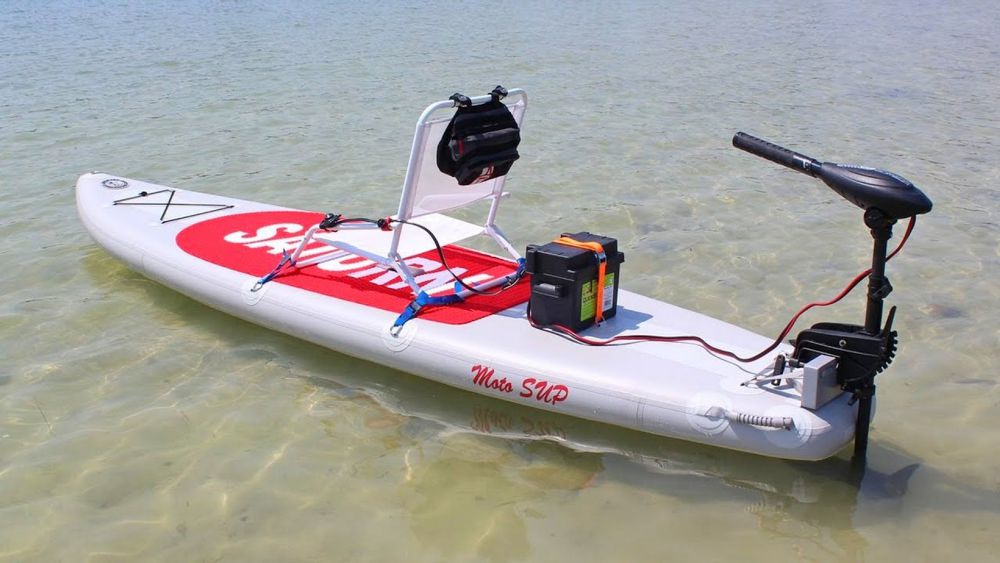
Conversely, if you frequently encounter strong currents or choppy waters, a heavier, more powerful motor would be a better choice despite the weight and battery life trade-off.
3. Shaft Length
Choosing the suitable trolling motor for paddle board hinges on various factors, including shaft length.
A shorter shaft is ideal for shallow waters, where a longer shaft might hit the bottom and cause damage. Conversely, longer shafts provide better propeller clearance in deeper waters, preventing weeds and debris from entangling and hindering the motor.
For example, a 30-inch shaft is suitable for depths up to 3 feet, while a 42-inch shaft is better suited for deeper waters exceeding 4 feet. Thus, you should select a shaft length compatible with your typical paddling environment to ensure optimal performance and prevent potential damage to the motor.
4. Thrust
For a trolling motor on stand up paddle board, the thrust factor, the ratio of static thrust to the motor’s amperage draw, is crucial. A higher thrust factor signifies greater efficiency in converting battery power into usable thrust, propelling your SUP further and for longer durations.
Understanding the thrust factor empowers you to choose a SUP trolling motor that delivers optimal performance for your paddling adventures.
5. Battery and battery life
The paddle board trolling motor, a popular choice for propelling stand-up paddle boards, relies heavily on its battery for performance and range.
Firstly, battery capacity directly influences the motor’s runtime. Higher capacity batteries, measured in amp-hours (Ah), allow for longer durations on the water before needing a recharge. This is crucial for extended trips or covering larger distances.
Secondly, battery weight can significantly impact the handling and maneuverability of a paddle board. Opting for lighter batteries, often achieved through lithium-ion technology, can enhance user experience, especially for smaller boards or solo paddlers.
Therefore, choosing the correct battery for a paddle board trolling motor requires balancing capacity, weight, and intended use.
Tips for Using a Paddle Board Trolling Motor
Do you want to cover more ground or give your arms a rest? Here are three essential tips to get the most out of using a motor with your paddle board:
Tip 1: Build a Transom Mount
The first step is to select a suitable paddle board trolling motor designed for SUPs. These motors are smaller and lighter than traditional boats, making them easier to maneuver and mount on a paddle board.
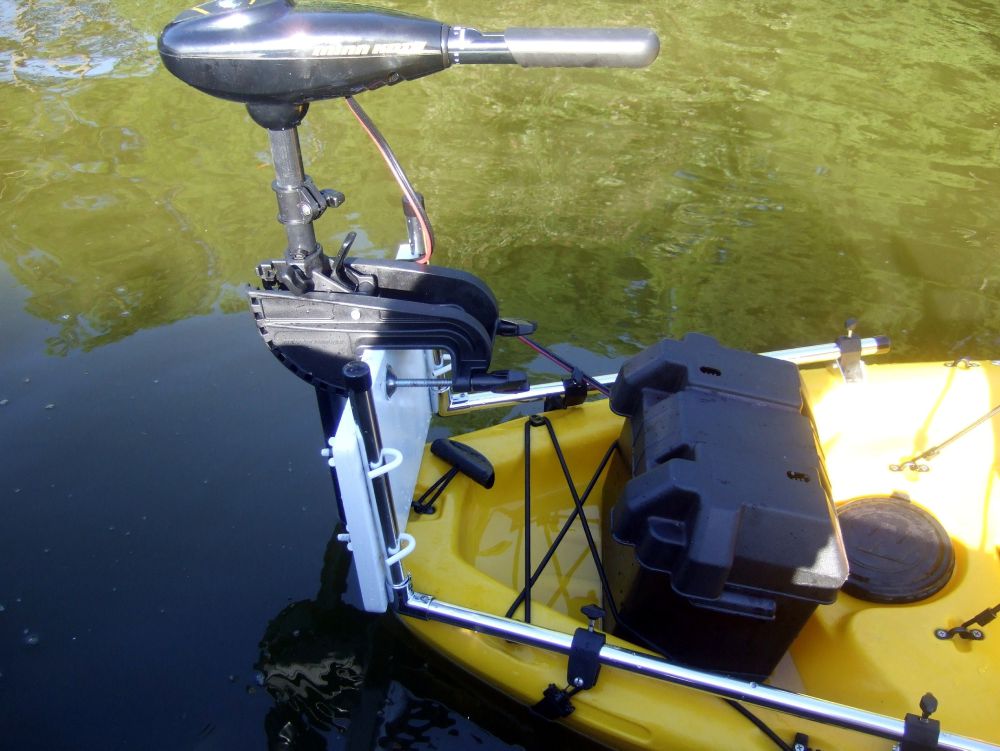
When it comes to the mount, there are a few options. One popular choice is to build a transom mount. This involves creating a sturdy wooden or plastic base that attaches to the rear of your paddle board. The paddle board trolling motor mount is then secured to the transom. Ensure the transom is strong enough to handle the motor’s weight and thrust.
Tip 2: Add Additional Fins
Adding a motor to your paddle board will naturally affect its stability. To counteract this, consider adding additional fins to your board. These fins will provide greater control and help you maintain your course, especially in windy or choppy conditions. Look for fins specifically designed for SUP use or those used on surfboards.
Tip 3: Opt for a dual SUP paddle
A dual SUP paddle provides versatility and convenience, making navigating with your motor a breeze. It has a traditional paddle blade on one end and a hook on the other. The hook can be a handy way to maneuver from a resting position or when in shallower water without needing to switch to your hands.
Gear to Have When using a Paddle Board with a Motor
Regardless of your motor choice, here’s some essential gear to consider when using a paddle board with a motor:
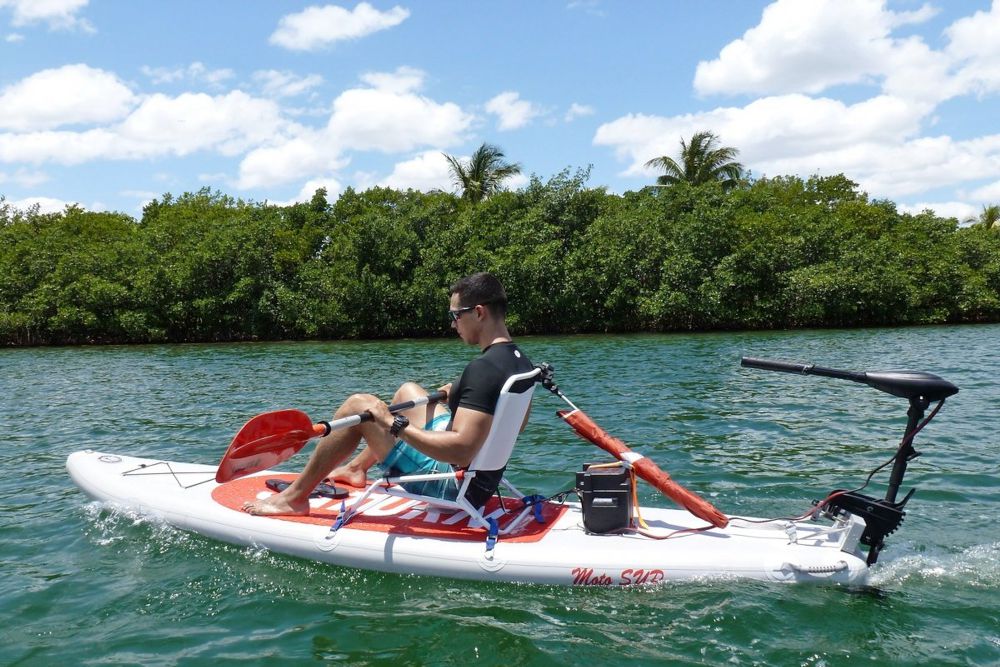
Emergency Stop Cord and Tether
This crucial safety feature functions similarly to a kill switch in a traditional motorboat. In the event of a fall, dismount, or other unforeseen circumstance, the emergency stop cord, when pulled, will immediately cut power to the motor, preventing the board from running away or injuring you or others. Look for a trolling motor for paddle board with a built-in emergency stop cord and rope, or purchase one separately to ensure compatibility with your specific motor and board setup.
SUP leash
A SUP leash is an essential safety gear for motorized paddle boards like a traditional paddle board. It tethers you to the board, preventing it from drifting away in case you fall or become separated. This is especially important in open water or challenging conditions. Choose a SUP leash appropriate for your weight and the size of your board.
Paddle Board Seat
While not mandatory, a paddle board seat can significantly enhance your comfort and control over your motorized board, particularly during extended journeys. It provides a stable and elevated position, allowing you to steer and operate the motor more effectively while reducing fatigue. Look for a seat designed for use with paddle boards and adjustable to fit your height and preferences.
PFD
A Personal Flotation Device (PFD), a life jacket, is a non-negotiable safety item for any water activity, including motorized paddle boarding. It provides buoyancy in case of an accidental fall or mishap, potentially saving your life.

Choose a PFD that is comfortable to wear and fits you snugly. Remember, even if you are a strong swimmer, a PFD can provide valuable peace of mind and increase your chances of staying afloat in an emergency.
By incorporating these four essential gears, you can significantly enhance the safety, comfort, and control of your paddle boarding experience when utilizing a paddle board trolling motor.
Trolling on Your SUP with Boost Fin
Overall, there are a few ways to add a paddle board trolling motor to upgrade your stand-up paddle boarding experience. Aftermarket motor mounts offer convenience, while DIY transom mounts provide flexibility if you’re handy. However, an electric fin like the Boost Fin is the most streamlined and powerful option.
Electric fins offer several advantages. They don’t add extra attachments that create drag, provide continuous power without paddling, and remain relatively affordable. While your choice ultimately depends on your needs and budget, we personally recommend the Boost Fin for its powerful electric trolling motor for paddle board, ease of use, and excellent portability. This is the best option to experience fishing adventures or leisurely cruises with less effort. What do you think? Let us know in the comment below!


Share:
Surfboard Fin Setups Guide: Types and Placements
12 Best Beginner Surf Spots Around the Globe